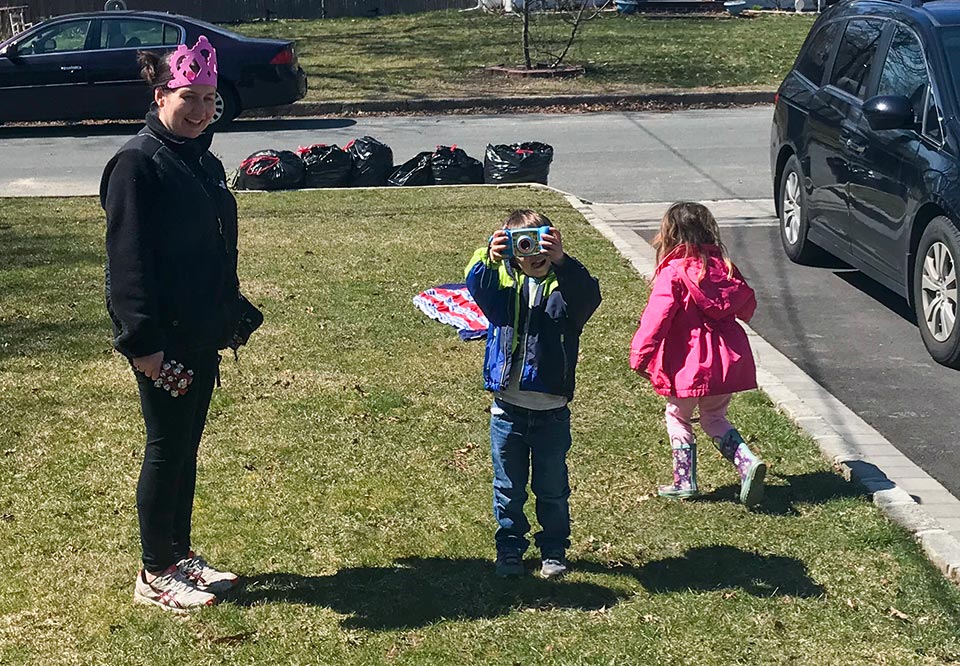It was Doug Cody’s 70th birthday the other day.
The adjunct professor was home, of course, because that’s what we do these days, and because he is teaching six courses on four different Long Island campuses — from the office in his house.
His daughter Andrea Darbee, a high school teacher in Hauppauge, brought her twins, nearly 5, over for a ‘drive-by’ celebration. They stayed on the grass while Cody and his wife, Fran, sat on the stoop. Cupcakes were enjoyed.
“They sang Happy Birthday papa and we had fun, but there were no hugs and kisses,” Cody said.
Welcome to the pandemic.

"SAY CHEESE, PAPA." Cody's daughter Andrea Darbee and her children wished him a socially distant happy birthday. Photo provided.
“My daughter is teaching 140 students online and providing daycare for the grandkids, and I’m going out of my mind trying to teach six different classes fully online,” Cody said. “But that’s nothing compared to what others, the health care providers and first responders on the front line, are going through. It's probably the craziest time in our lives.”
Cody teaches two courses on different campuses at Suffolk Community College, three courses at SUNY Farmingdale and one at Nassau CC. He’s a member of NYSUT affiliates United University Professions and the FA at Suffolk. He’s also a member of the adjunct union at Nassau. He’s been a professor and unionist for decades.
“I really love what I do,” he said, “and I believe face-to-face is the only way to teach people.” So, for the last few weeks, he’s been trying to continue that.
The colleges asked faculty in every course that could conceivably be taught online, including some pretty hands-on subjects like Cody’s chemistry sections, to “tech up” and figure it out.
Most are using Zoom, Google Meet, or Webex to try to convene at the time when the class would actually meet. It’s like a class session done remotely, not like a distance learning model, which would be designed for individual work time. It requires more prep time to convert classroom materials and a need to be available for questions at all hours, as well.
Cody said he does his best, but “It’s just not the same. Being face-to-face with students is extremely important. You can tell if they are engaged, and you can see right away if they understand. It cannot possibly be the same.”
Darbee was put in a similar position, told to suddenly change the way she works and the way she lives.
“I think my district administration is working as a team under really dire circumstances to do what’s best for kids,” said the member of the Hauppauge Teachers Association. But it’s a huge difference. She teaches college-level composition and it’s not the most natural curriculum to convert for remote teaching.
“I get up between 5:30 and 6 a.m. every morning and head to the basement where I work on the computer until 10:30. I post documents on Google classroom; I record myself for presentations; I grade papers; I communicate with students to provide feedback on work.” The rest of the day, she has to teach classes, and watch over her twins.
Overall, teachers are trying their best to meet the needs of students, Darbee said. “We don’t have all the answers, but we’re dancing as fast as we can.”
Remote contact complicates another aspect of the job — understanding the issues students face at home.
“We don’t know: Is there COVID-19 in the house? Are there first responders in the family? Are the parents or other family members laid off?” All teachers know these factors would affect student success as well as social/emotional health, she said.
Needless to say, these kinds of remote instruction may raise issues we have not even identified yet, and educators will have to deal with them when they arise.
For now, “I’m happy to be a part of a union,” Darbee said.